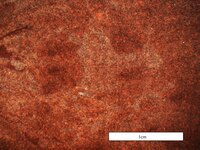| This article relies largely or entirely on a single source. Relevant discussion may be found on the talk page. Please help improve this article by introducing citations to additional sources. Find sources: "Erytholus" – news · newspapers · books · scholar · JSTOR (June 2024) |
| Erytholus Temporal range: Middle Cambrian PreꞒ Ꞓ O S D C P T J K Pg N | |
|---|---|

| |
| Crack-out specimen of Erytholus globosus from the Middle Cambrian, Moodlatana Formation, of the Flinders ranges, South Australia | |
| Scientific classification | |
| Kingdom: | Incertae sedis |
| Genus: | †Erytholus Retallack 2011 |
| Species | |
| |


Erytholus is a form genus for problematic fossils of Cambrian age in South Australia. It has been of special interest because of its morphological similarity with the Ediacaran fossil Ventogyrus, and may have been a late surviving vendobiont. It could be a slime mold.
Description
Erytholus is a globose, chambered fossil, with associated vertical tubular structures. Its preservation in sandstone is similar to the Ediacaran type preservation of the vendobiont Ventogyrus. It is found at depths of 20–30 centimetres (7.9–11.8 in) within paleosols. Its affinities are uncertain, although it bears a general resemblance to truffles.
References
- ^ Retallack, G.J. (2011). "Problematic megafossils in Cambrian paleosols of South Australia". Palaeontology. 54 (6): 1223–1242. Bibcode:2011Palgy..54.1223R. doi:10.1111/j.1475-4983.2011.01099.x. S2CID 130692406.
This prehistoric biota article is a stub. You can help Misplaced Pages by expanding it. |